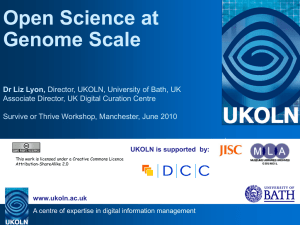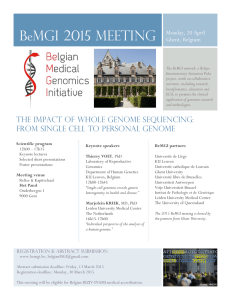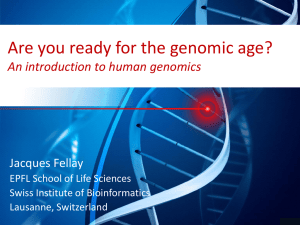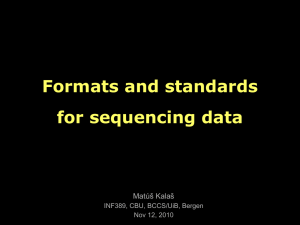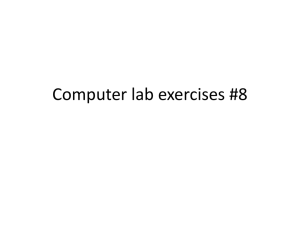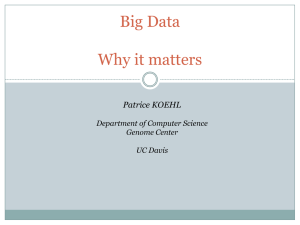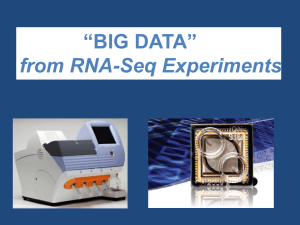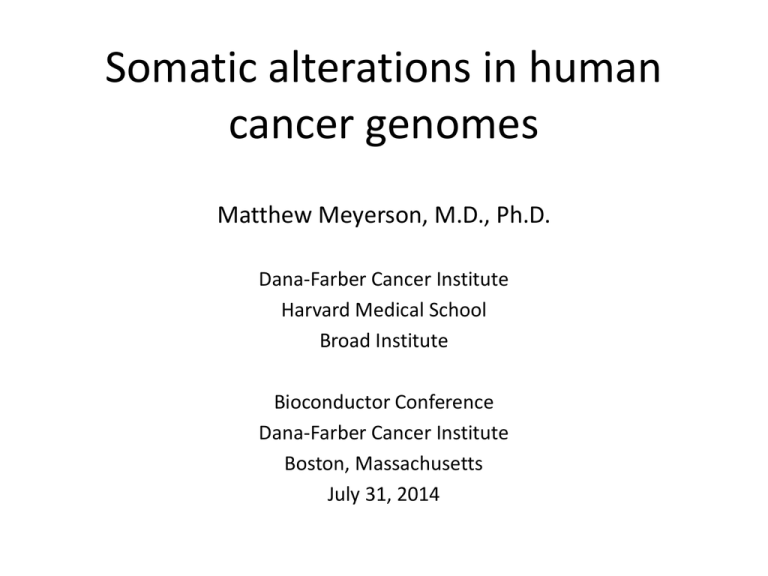
Somatic alterations in human
cancer genomes
Matthew Meyerson, M.D., Ph.D.
Dana-Farber Cancer Institute
Harvard Medical School
Broad Institute
Bioconductor Conference
Dana-Farber Cancer Institute
Boston, Massachusetts
July 31, 2014
Somatic genome alterations and
cancer therapy
Every cancer genome is uniquely altered
from its host normal genome
“Happy families are all alike; every unhappy
family is unhappy in its own way”.
Leo Tolstoy, Anna Karenina
Normal human genomes are all (mostly) alike; every
cancer genome is abnormal in its own way.
Each cancer genome has a unique set of genome
alterations from its normal host
These alterations, however, are not random but act in
common pathways and mechanisms
Somatic genome alterations are central to
cancer pathogenesis
While germ-line mutations can increase the risk of cancer,
most cancer causing mutations are somatic
Somatic mutations are present in the cancer DNA but not in the
germ-line DNA
Somatic alterations can provide a large therapeutic window
Genome-targeted treatments can be selective for the genomically
altered cancer cell and spare the rest of the body, which is
genomically normal
Somatic alterations are internally controlled
Comparison between germ-line and cancer defines the cancerspecific alterations and allows precise diagnosis
Mutation-targeted therapies can be highly
effective in cancer treatment
Before
treatment
After 2
months
erlotinib
treatment
Response to erlotinib (Tarceva) treatment of a patient with lung adenocarcinoma, with a
somatic EGFR deletion mutant in exon 19 ( thanks to Bruce Johnson, M.D., DFCI)
Often, only patients whose cancers have mutated
therapeutic targets will benefit from targeted therapy
Patients with EGFR mutant lung cancer benefit from gefitinib
While those with EGFR wild type lung cancer do not benefit
Mok et al., NEJM, 2009
A growing armamentarium of genomically
targeted cancer therapies
Gene
Mechanism of Activation
Targeted Inhibitor
ABL
ALK
BRAF
DDR2
EGFR
ERBB2
FGFR1
FGFR2
FGFR3
KIT
MET
PDGFRA
RET
ROS1
rearrangement
imatinib, dasatinib, nilotinib, bosutinib
rearrangement, mutation
crizotinib
mutation, rearrangement
vemurafenib, dabrafenib
mutation
dasatinib
mutation
erlotinib, gefitinib, afatinib, cetuximab, panitumumab
mutation, amplification
trastuzumab, lapatinib, pertuzumab
amplification, rearrangement
ponatinib
mutation, rearrangement
ponatinib
mutation
ponatinib
mutation
imatinib, sunitinib, regorafenib, pazopanib
amplification, mutation
crizotinib
mutation, rearrangement
imatinib, sunitinib, regorafenib, pazopanib
rearrangement, mutation
cabozantinib
rearrangement
crizotinib
Application of high-throughput
genomic analysis to cancer
Increasing power of genome sequencing
technology
Genomic mechanisms of cancer
(germline and somatic)
Amplification/
deletion
Mutation
AGT
Arg
CGT
Cys
GGT
Gly
TGT
Ser
GAT
Asp
GCT
Ala
GTT
Val
Translocation
Infection
Sequencing can discover all classes of cancer genome alteration
Meyerson, Gabriel, Getz, Nat Rev Genet, 2010
Approaches to cancer genome sequencing
Whole genome
Complete sequence of entire genome (3 billion bases—currently
typically 30x coverage)
Transcriptome
Sequencing of all messenger RNAs
Whole exome
Complete sequence of all exons of coding genes (~30 million bases,
currently typically 150x coverage)
Targeted exome/plus
Complete sequences of exons and rearrangement sites from selected
cancer-related genes, such as oncogenes and tumor suppressor genes
(can achieve up to 1000x coverage)
The Cancer Genome Atlas (TCGA)
More than 30 cancer
histologies, incl…
10,000 cancer/normal
paired specimens
Biospecimen Core
Resource
Lung adenocarcinoma
Lung squamous carcinoma
Breast carcinoma
Colorectal carcinoma
Renal cell carcinoma
Endometrial carcinoma
Glioblastoma
Ovarian carcinoma
Bladder carcinoma
HNSCC
Acute myeloid leukemia
Exome & transcriptome
sequencing, copy number &
methylome analysis, …
Cancer Genomic
Characterization
Centers
•
•
•
•
•
•
•
Genome
Sequencing
Centers
•
Genome Data Analysis
Centers
Data Coordinating
Center
•
•
•
•
•
•
Clinical diagnosis
Treatment history
Histologic diagnosis
Pathologic report/images
Tissue anatomic site
Surgical history
Gene expression/RNA
sequence
Chromosomal copy
number
Loss of heterozygosity
Methylation patterns
miRNA expression
DNA sequence
RPPA (protein)
Subset for Mass Spec
Whole genome sequencing
underway for 1000
cancer/normal pairs
How do we find a cancer gene?
How do we define a therapeutic
target?
Genome alterations in squamous cell
lung carcinoma: an illustration of
computational and experimental
issues in cancer gene discovery
Lung cancers are characterized by common
chromosome arm level alterations
Lung adenocarcinoma
Squamous cell lung carcinoma
Some differences
between SqCC
and AdC.
Loss
Gain
Andrew Cherniack, TCGA
Arm-level chromosomal alterations are approximately the most
common somatic genome alteration across all human cancers
Most frequently
somatically
mutated genes
(exome):
TP53: 36%
PIK3CA: 14%
PTEN: 8%
Source:
www.tumorportal.org
Beroukhim et al., Nature, 2010
Athough there are tumor-type specific differences, most
chromosome arms are either recurrently gained or recurrently lost,
not both
Beroukhim et al., Nature, 2010
Do chromosome arm level alterations contribute
to cancer? And if so, how?
Does the statistical recurrence imply that the chromosome
arm-level gains and losses are important, or merely
tolerated?
If chromosome arm level copy changes are important, are
they do to single genes or multiple genes per arm?
Or are they due to systemic effects on the genome?
On the computational level, what are effects of individual
arm level copy changes, and total aneuploidy, on gene
expression within tumors?
Focal chromosome alterations in lung cancers
Lung adenocarcinoma
Squamous cell lung carcinoma
9p loss
14q gain
Loss
Gain
Andrew Cherniack, TCGA
Copy number structure of most common amplification in lung
adenocarcinoma (14q13) mapping to NKX2-1
Barbara Weir & Gaddy Getz
Finding targets of focal genome alterations:
Statistical recurrence is key to defining
genome alterations but we need to find the
right background model by understanding the
biological variations in the genome
Evaluating significance of copy number alterations:
Genomic Identification of Significant Targets In Cancer (GISTIC)
Measure the amplitude of copy number gain or loss at each
position in each sample
Sum this amplitude across all samples
Assign significance for the alteration (false discovery rate) by
comparison to randomly permuted data
Beroukhim, Getz et al. , PNAS, 2007
Focal copy number alterations in
squamous cell lung carcinoma
Deletion
Amplification
MYCL
MCL1
REL
NFE2L2
SOX2
PDGFRA
EGFR
LRP1B
ERBB4
FOXP1
CSMD1
CDKN2A
FGFR1
PTEN
CCND1
MDM2
RB1
ERBB2
CRKL
TCGA, Nature, 2012
Problem: can we build a statistical model for
focal chromosomal alterations that allows us
to identify all copy number altered oncogenes
and tumor suppressor genes?
Challenge: genome is complex with
many rearrangements
Rearrangement junctions
A better model for determining significance of
copy number alterations could be built from
whole genome sequence data and would
require understanding of genome structure
How to find significant mutations
in cancer over background?
Squamous cell lung cancer has a very
high rate of somatic mutations
Hematologic
Childhood
Carcinogens
Top mutated genes in squamous cell lung
cancer (crude analysis)
Top mutated genes in squamous cell lung
cancer (expression-filtered significance)
TCGA, Nature, 2012
The problem of mutation significance is even
larger in whole genome sequence data
• The problem of background mutation rate is particularly
high in regions of non-coding DNA/heterochromatin
• We see up to about 50-fold variation in mutation rates
between regions of the genome
• What is the best model to correct for this
Peter Hammerman, Akin Ojesina
Splicing factor alterations: what are
their transcriptome consequences
Significantly mutated genes in lung adenocarcinoma
Imielinski et al., Cell, 2012
Somatic mutations can disrupt mRNA splicing
regulation
SF3B1
Splicing factors
U2AF1
(U2AF35)
Splicing regulatory
sequences
GU
UGUGAA
enhancer 5’ss
35
YUNAY
branch
point
YYYYY
AG
polypyrimidine3’ss
tract
GAACCA
enhancer
Alternative splicing of MET exon 14 in TCGA lung
adenocarcinoma RNA sequencing data
Percent Spliced In, %
Normal MET
transcript:
contains exon 14
in 220 samples
Y1003*
3’ss 19bp del
Abnormal MET
transcript: lacks
exon 14 in 10
samples
5’ss +3
Kong-Beltran et al.
2006, Onozato et al.
2009; Seo et al., 2012
5’ss 12bp del
No MET splice site mutation
MET splice site mutation
TCGA/Angela Brooks
Percent Spliced In, %
All MET exon 14 skipping samples are,
otherwise, oncogene negative
37
No MET splice site mutation
n=224
MET splice site mutation
n=6, one sample has low expression
TCGA/Alice Berger
Transcriptome / “spliceome” correlates to genome
alterations
• Effects of cis mutations on transcriptome—both near
and far
• Effects of trans mutations (e.g. splicing factor
mutations) on specific gene splicing
– On specific gene expression
– On global gene expression
Pathogen Discovery from
Sequencing Data
Alex Kostic
Chandra Pedamallu
Akin Ojesina
Joonil Jung
Ami Bhatt
Sequence-based computational subtraction for
pathogen discovery
Principle
The human genome sequence is nearly complete
Infected tissues contain human and microbial RNA and DNA
Generate & sequence
libraries from human
tissue
Normal human sequences can be
subtracted computationally
Computational
subtraction
Remainder is of non-human origin:
disease-specific sequences can be
validated experimentally
Weber et al., Nature Genetics, 2002
40
PathSeq: software to identify or discover microbes by
deep sequencing of human tissue
Kostic et al., Nature Biotechnology, 2011
Pathogen analysis of 9 colorectal cancer/normal
genome pairs
PathSeq
Initial analysis identifies tumor-enrichment of
Fusobacterium and Streptococcaceae
LEfSe: Linear Discriminant Analysis (LDA)
coupled with effect size measurements
• Wilcoxon sum-rank test followed by
LDA analysis
• Segata et al., 2012
Kostic et al., Genome Research, 2012
Cord Colitis Syndrome
• Idiopathic, antibioticresponsive diarrheal
syndrome
• Affected umbilical cord blood
transplant patients between
~60d and 1y after
transplantation
• 11 histopathologically
confirmed cases between
2004-2011 at BWH
• All microbiology studies
negative
Herrera AF, Soriano G et al. NEJM 2011
Classification of the CCS-associated bacterium
• Phylogenetic analysis
using the draft
genome to classify the
organism
Comparison of B. enterica to B.
japonicum
• Filamentous hemagglutinin
genes
• Genes critical for Carbon
fixation
CCS organism
PhyloPhlAn
N. Segata, C. Huttenhower
Challenges in sequence-based pathogen discovery
• How to analyze unclassified/unclassifiable reads
• Developing a fast algorithm for very large data sets
• Assignment of reads to nearest organisms
Summary: some challenges in somatic cancer
genomics
• Whole genome and whole transcriptome sequencing
provide unprecedented opportunities for
understanding cancer development and evolution
• ...but require development of many computational
tools
– New models for copy number significance (and
rearrangement significant) using whole genome sequence
data and developing appropriate background models
– Ways to determine significance of non-coding mutations with
appropriate background models
– Finding non-human sequence data in large sequencing data
sets to find new disease organisms
Acknowledgements
Meyerson laboratory
Dana-Farber Cancer Institute colleagues
Broad Institute colleagues
Alice Berger
Ami Bhatt
Angela Brooks
Scott Carter
Andrew Cherniack
Juliann Chmielecki
Peter Choi
Luc de Waal
Josh Francis
Hugh Gannon
Heidi Greulich
Elena Helman
Bryan Hernadez
Marcin Imielinski
Joonil Jung
Bethany Kaplan
Nathan Kaplan
Alex Kostic
Rachel Liao
Wenchu Lin
Akinyemi Ojesina
Chandra Pedamallu
Trevor Pugh
Tanaz Sharifnia
Alison Taylor
Hideo Watanabe
Cheng-Zhong Zhang
Adam Bass
Rameen Beroukhim
Michael Eck
Levi Garraway
Nathanael Gray
Bill Hahn
Peter Hammerman
Pasi Janne
Bruce Johnson
Matt Kulke
Keith Ligon
David Pellman
Scott Pomeroy
Ramesh Shivdasani
Kwok-kin Wong
Kristian Cibulskis
Stacey Gabriel
Gad Getz
Todd Golub
Jaegil Kim
Eric Lander
Mike Lawrence
Tim Lewis
Lee Lichtenstein
Ben Munoz
Beth Nickerson
Mike Noble
Mara Rosenberg
Gordon Saksena
Stuart Schreiber
Carrie Sougnez
Selected alumni
Jordi Barretina, Novartis
Jeonghee Cho, Samsung
Tom Laframboise, Case Western
Se-Hoon Lee, Seoul National U.
Katsuhiko Naoki, Keio U.
Orit Rozenblatt-Rosen, Broad Institute
Xiaojun Zhao, Novartis
Dana-Farber CCGD
Collaborators at other institutions
Ravali Adusumili
Marc Breineser
Deniz Dolzen
Matt Ducar
Megan Hanna
Robert Jones
Jack Lepine
Laura MacConaill
Adri Mills
Laura Schubert
Ashwini Sunkavalli
Aaron Thorner
Paul van Hummelen
Liuda Ziaugra
Sylvia Asa, Toronto
Jose Baselga, MSKCC
Steve Baylin, Johns Hopkins
David Carbone, Ohio State
Eric Collisson, UCSF
Aimee Crago, MSKCC
Ramaswamy Govindan, Wash U
Neil Hayes, UNC
Santosh Kesari, UCSD
Marc Ladanyi, MSKCC
John Maris, UPenn
Chris Love, MIT
William Pao, Vanderbilt
Harvey Pass, NYU
Niki Schultz, MSKCC
Sam Singer, MSKCC
Josep Tabernero, Vall d’Hebron
Roman Thomas, Koln
Bill Travis, MSKCC
Matt Wilkerson, UNC
Thomas Zander, Koln
Acknowledgements: The Meyerson Laboratory



